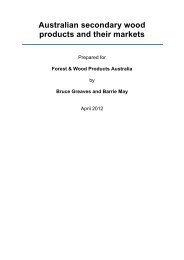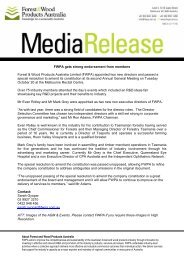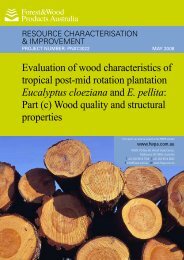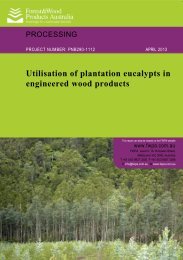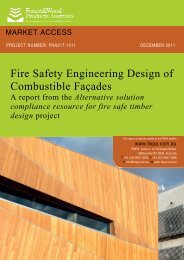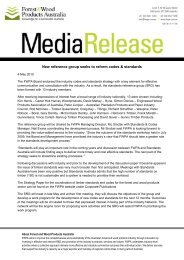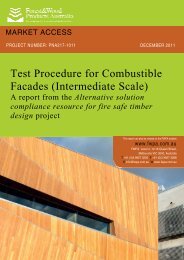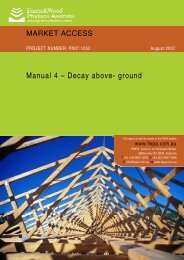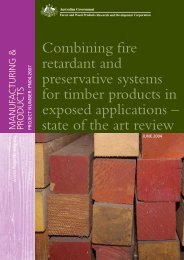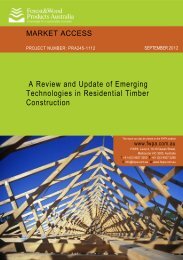ANNUAL REPORT 09/10 - Forest and Wood Products Australia
ANNUAL REPORT 09/10 - Forest and Wood Products Australia
ANNUAL REPORT 09/10 - Forest and Wood Products Australia
Create successful ePaper yourself
Turn your PDF publications into a flip-book with our unique Google optimized e-Paper software.
34 | OPERATIONS<br />
Assessing the properties of young plantation<br />
hardwood sapwood <strong>and</strong> its marketability<br />
Providing industry with information on effectively<br />
using new resources enables companies to adapt<br />
their business <strong>and</strong> processing models to maximise<br />
productivity <strong>and</strong> profi tability.<br />
To meet market dem<strong>and</strong> <strong>and</strong> maintain productivity <strong>and</strong><br />
profi tability, the hardwood processing industry must<br />
change to using increasing proportions of plantation<br />
resources. For this move to be successful, more needs<br />
to be known about the properties of young, fast grown<br />
hardwood, particularly as recovery losses by removing<br />
sapwood become signifi cant as log diameter decreases.<br />
This study assessed the physical properties <strong>and</strong><br />
appearance of both the sapwood <strong>and</strong> heartwood of nine<br />
species from plantation <strong>and</strong> young regrowth regimes,<br />
<strong>and</strong> compared results with data on native forests. Results<br />
showed the mechanical properties of sapwood (other<br />
than bending) to be at least equivalent to heartwood,<br />
while machinability, stain uptake <strong>and</strong> fi nish quality of fl oor<br />
<strong>and</strong> veneered panels were of a high quality. An estimated<br />
additional $33 to $113 per m 3 of processed log could<br />
be earned if sapwood was retained for use in solid<br />
wood products (with the exception of some appearance<br />
grade products).<br />
PNB039-0708 The impact of sapwood, <strong>and</strong> the properties <strong>and</strong><br />
market utilisation of plantation <strong>and</strong> young hardwoods.<br />
FWPA <strong>ANNUAL</strong> <strong>REPORT</strong> <strong>09</strong>/<strong>10</strong><br />
Left: BING – equipment used for the acquisition of the offline<br />
acoustic signals. Right: Log end with labelled template<br />
for locating position in tree after sawing (note vibration<br />
sensor attached near the pith for determining the acoustic<br />
properties of the log).<br />
Investigating non-destructive grading<br />
of softwoods<br />
Next generation grading technology has the potential to<br />
enable sawmills to optimise cost of operation.<br />
Current commercial softwoods, such as radiata <strong>and</strong><br />
Caribbean pine, are an important source of structural<br />
timber, but the variable properties of wood from these<br />
fast-grown trees means that mills must sort the timber<br />
into appropriate stress groups to ensure safety <strong>and</strong><br />
performance. Currently this grading takes place once the<br />
logs have been cut into boards <strong>and</strong> undergone costly<br />
drying. In this study, researchers assessed the usefulness<br />
of non-destructive grading techniques that are conducted<br />
before logs are cut or dried. The results showed that<br />
these non-destructive tests gave a good indication of the<br />
boards’ fi nal stiffness. In particular, grading green boards<br />
before drying could reduce the volume of non-structural<br />
boards that are dried by 5 to 8%, with an associated<br />
saving of $70 to $85 per m 3 .<br />
PNB040-0708 MOE <strong>and</strong> MOR assessment technologies for<br />
improving graded recovery of exotic pines in <strong>Australia</strong>.



